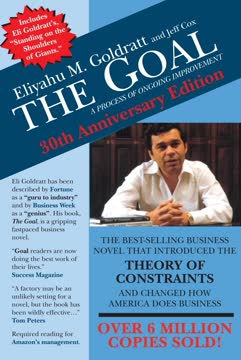Key Takeaways
1. Complexity requires adaptive management, not linear thinking
Linear thinking minds see the world as a place full of easily explainable events with simple causes and simple effects.
Embrace complexity. Traditional management approaches often rely on causal determinism and linear thinking, assuming that events have simple causes and effects. However, real-world systems, including software projects and organizations, are complex adaptive systems. They exhibit nonlinear behavior, emergent properties, and unpredictable outcomes.
Shift your mindset. To effectively manage in complex environments:
- Recognize that not everything can be planned or controlled
- Expect and embrace uncertainty and change
- Focus on adaptability rather than rigid predictability
- Understand that small changes can have large, unforeseen consequences
- Look for patterns and relationships rather than simple cause-effect links
2. Agile software development embraces complexity and self-organization
Agile software development was the practical implication of treating software teams and projects as complex systems.
Agile principles align with complexity. Agile methodologies acknowledge the inherent complexity of software development by emphasizing:
- Iterative and incremental development
- Continuous feedback and adaptation
- Cross-functional, self-organizing teams
- Close collaboration with customers
- Embracing change rather than following a fixed plan
Key Agile concepts from complexity science:
- Self-organization: Teams organize themselves to solve problems
- Emergence: Solutions and practices evolve through the development process
- Feedback loops: Regular inspect-and-adapt cycles drive improvement
Agile approaches provide a framework for managing complexity in software projects, allowing teams to navigate uncertainty and respond to changing requirements more effectively than traditional, plan-driven methods.
3. Empowering teams is crucial for managing complex systems
Smart managers understand that they must try to make as few decisions as possible. For better overall control of a complex system, most of the decisions should be made in the subsystems.
Delegate decision-making. In complex systems, no single individual can possess all the information needed to make optimal decisions. Empowering teams to make decisions at the local level leads to better outcomes because:
- Teams have more detailed, up-to-date information about their work
- Decisions can be made faster, improving responsiveness
- It leverages the collective intelligence and diverse perspectives of team members
Balance empowerment and alignment. Managers should:
- Provide clear goals and constraints to guide team decision-making
- Gradually increase team autonomy as they demonstrate competence
- Foster a culture of trust and accountability
- Remove obstacles and provide resources to support team success
- Focus on outcomes rather than micromanaging processes
4. Align constraints to guide self-organization towards valuable outcomes
Self-organization is fundamental for every complex system. But in a human social system, self-organization alone is not enough.
Self-organization needs direction. While self-organization is a powerful force in complex systems, it doesn't guarantee desirable outcomes for an organization. Managers play a crucial role in:
- Developing the system: Creating an environment conducive to self-organization
- Protecting the system: Safeguarding people and shared resources
- Directing the system: Aligning self-organization with organizational goals
Effective constraint alignment:
- Define clear, shared goals that transcend individual interests
- Establish boundaries within which teams can self-organize
- Create a "social contract" outlining mutual expectations
- Balance freedom and responsibility
- Regularly communicate and reinforce the vision and purpose
By setting the right constraints, managers can harness the power of self-organization while ensuring it produces value for the organization and its stakeholders.
5. Develop competence through multiple approaches, not just processes
To know how a business performs, we need to measure it, which requires measurements on multiple organizational levels and in multiple dimensions: people, tools, functionality, quality, time, process, and value.
Holistic competence development. Instead of relying solely on process maturity models, organizations should foster competence through multiple complementary approaches:
- Self-development
- Coaching
- Certification
- Peer pressure
- Adaptable tools
- Supervision
- Management
Measure comprehensively. Assess performance across multiple dimensions:
- Functionality: Features delivered, velocity
- Quality: Defect rates, customer satisfaction
- Tools: Efficiency gains, cost-effectiveness
- People: Skill development, engagement
- Time: Delivery speed, time-to-market
- Process: Adherence to best practices, continuous improvement
- Value: Business impact, return on investment
By taking a multi-faceted approach to competence development and measurement, organizations can build resilient, high-performing teams capable of adapting to complex challenges.
6. Craft rules carefully to enable adaptability and innovation
Agile software development is not in the first place about pair programming, TDD, or user stories. [...] The more you're imposing them as fixed rules, the more you are constraining the innate rulemaking capabilities of your team members.
Balance structure and flexibility. Rules and practices are necessary for coordination and quality, but overly rigid rules can stifle creativity and adaptability. To foster innovation:
- Allow teams to develop their own rules and practices within constraints
- Encourage experimentation and learning from failures
- Focus on principles and outcomes rather than prescriptive processes
- Regularly review and adapt rules based on feedback and changing circumstances
Promote craftsmanship. Emphasize the development of skills and discipline alongside process adherence:
- Encourage continuous learning and skill improvement
- Foster a culture of excellence and pride in workmanship
- Balance individual creativity with team collaboration
- Recognize and reward both technical excellence and adaptability
By crafting rules thoughtfully, organizations can create an environment that supports both structure and innovation, enabling teams to respond effectively to complex challenges.
7. Structure organizations to optimize communication and collaboration
Communication = Information * Relationships * Feedback
Design for effective communication. Organizational structure significantly impacts how information flows and how people collaborate. To optimize communication:
- Create small, cross-functional teams to minimize communication barriers
- Foster strong relationships through co-location or effective virtual collaboration tools
- Establish feedback mechanisms to ensure shared understanding
- Recognize and leverage different communication styles and strengths within the team
Network thinking. View your organization as a complex network:
- Identify and nurture key connectors, influencers, and information brokers
- Create opportunities for informal communication and knowledge sharing
- Balance specialization with cross-pollination of ideas
- Use social network analysis to understand and improve communication patterns
By intentionally structuring organizations to support effective communication and collaboration, managers can harness the collective intelligence of their teams and navigate complexity more successfully.
Last updated:
FAQ
What's Management 3.0 about?
- Agile Management Focus: Management 3.0 by Jurgen Appelo emphasizes adapting management practices to support Agile software development, integrating complexity theory with practical strategies.
- Complex Adaptive Systems: The book views organizations as complex adaptive systems, helping managers understand team dynamics and the unpredictability of outcomes.
- Six Views Model: It introduces six key views: Energize People, Empower Teams, Align Constraints, Develop Competence, Grow Structure, and Improve Everything, providing a comprehensive framework for Agile management.
Why should I read Management 3.0?
- Practical Guidance: The book offers actionable insights for managers adapting to Agile methodologies, making it a valuable resource for leadership roles.
- Addressing Management Gaps: It fills a gap in literature by focusing on the role of managers in Agile settings, often overlooked in other resources.
- Engaging Style: Jurgen Appelo's writing is accessible and engaging, using humor and real-world examples to make complex theories understandable.
What are the key takeaways of Management 3.0?
- People-Centric Approach: Emphasizes that people are the most critical element in any organization, focusing on energizing and motivating teams.
- Self-Organization as Default: Teams naturally organize themselves, and managers should facilitate this process rather than impose rigid structures.
- Empowerment is Essential: Delegating authority and trusting teams to navigate challenges is crucial for effective management in complex systems.
What is the Management 3.0 model?
- Six Views Framework: Consists of Energize People, Empower Teams, Align Constraints, Develop Competence, Grow Structure, and Improve Everything, each addressing different aspects of managing Agile teams.
- Complexity Theory Integration: Recognizes organizations as complex adaptive systems, helping managers understand team interactions and emergent behaviors.
- Practical Application: Each view is supported by practical techniques and strategies that managers can apply in their organizations.
How does Management 3.0 define self-organization?
- Natural Team Behavior: Described as the natural behavior of teams, organizing activities without central authority, fundamental to Agile operations.
- Emergent Properties: Self-organization leads to emergent properties, where the whole is greater than the sum of its parts, achieving outcomes beyond individual capabilities.
- Context Matters: Influenced by the context in which teams operate, managers must create environments that support and encourage self-organization.
What are the best quotes from Management 3.0 and what do they mean?
- Complex Problems Quote: "For every complex problem there is an answer that is clear, simple, and wrong." Highlights the need for nuanced understanding of complexity in management.
- Self-Organization Definition: "Self-organization is the process where a structure or pattern appears in a system without a central authority." Reflects the core principle of Agile management.
- Employee Well-being Quote: "People who feel good about themselves produce good results." Emphasizes the link between employee well-being and productivity.
How does Management 3.0 address motivation?
- Intrinsic vs. Extrinsic Motivation: Focuses on intrinsic motivation driven by personal satisfaction over extrinsic rewards, fostering creativity and innovation.
- Ten Desires of Team Members: Outlines ten intrinsic desires like competence, autonomy, and relatedness, crucial for motivating teams.
- Eliminating Demotivation: Emphasizes identifying and eliminating factors that demotivate employees to enhance motivation and performance.
What is the relationship between diversity and innovation in Management 3.0?
- Diversity as a Strength: Argues that diversity enhances creativity and problem-solving, leading to more innovative solutions.
- Connectivity Over Gender: Emphasizes diversity focusing on connectivity and collaboration rather than just demographic factors.
- Inclusive Diversity: Introduces inclusive diversity, balancing common ground with valuing diverse perspectives for effective teamwork.
How can managers implement the principles of Management 3.0?
- Adopt the Six Views: Integrate the six views of the Management 3.0 model into leadership practices, focusing on energizing people and empowering teams.
- Encourage Self-Organization: Allow teams to self-organize, enhancing collaboration and innovation by creating a supportive context.
- Focus on Continuous Improvement: Promote a culture of continuous improvement through retrospectives and open discussions about team processes.
What is the SLIP model in Management 3.0?
- Simple Linear Improvement Process: Consists of eight steps for continuous improvement, providing a structured approach to managing efforts.
- Iterative Nature: Emphasizes that improvement is not always linear, reflecting the reality of navigating complex systems.
- Feedback and Learning: Incorporates feedback loops to ensure teams learn from experiences, allowing for adjustments based on outcomes.
How does Management 3.0 address the concept of failure?
- Learning from Mistakes: Posits that errors and failures are valuable learning opportunities, leading to greater insights and improvements.
- Postponing Failure: Defines success as the ability to postpone failure, encouraging resilience and adaptability over perfection.
- Iterative Process: Views failure as integral to the iterative process, encouraging experimentation and adaptation based on experiences.
What role does communication play in Management 3.0?
- Foundation of Trust: Essential for building trust within teams, fostering a collaborative environment through transparency and openness.
- Facilitating Change: Helps facilitate change by ensuring everyone understands goals and processes, reducing resistance and encouraging buy-in.
- Enhancing Collaboration: Emphasizes communication's role in enhancing collaboration, leading to better coordination and effective teamwork.
Review Summary
Management 3.0 receives high praise for its innovative approach to leadership and agile development. Readers appreciate its practical advice, comprehensive overview, and theoretical foundations in complexity theory. Many find the humor and writing style engaging, though some struggle with its density. The book's strengths include its scientific approach, actionable insights, and extensive references. Critics note that some ideas may be outdated, and the content can be overwhelming. Overall, it's considered a valuable resource for managers seeking to improve their agile leadership skills, despite occasional challenges in readability.
Similar Books










Download PDF
Download EPUB
.epub digital book format is ideal for reading ebooks on phones, tablets, and e-readers.




